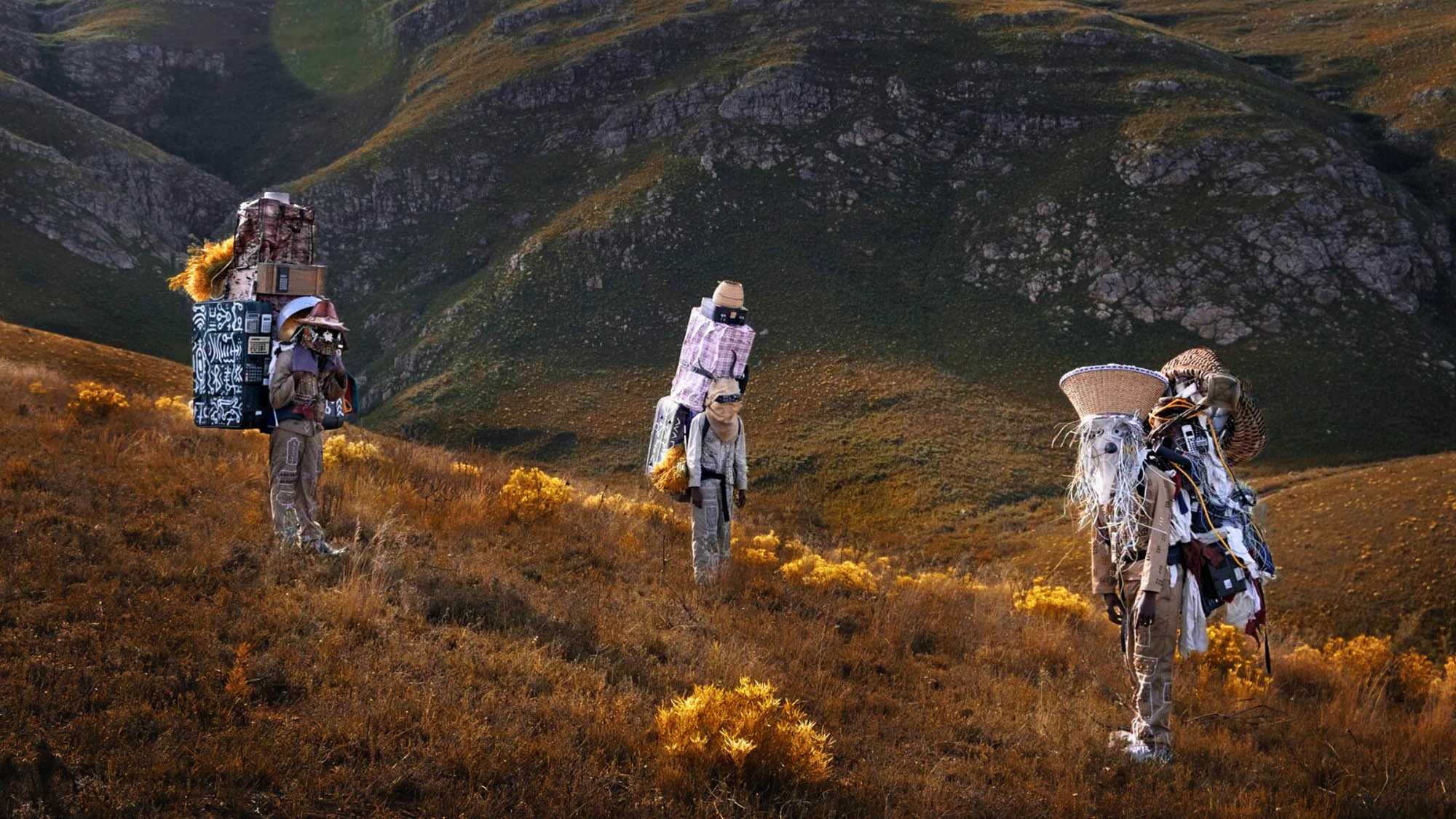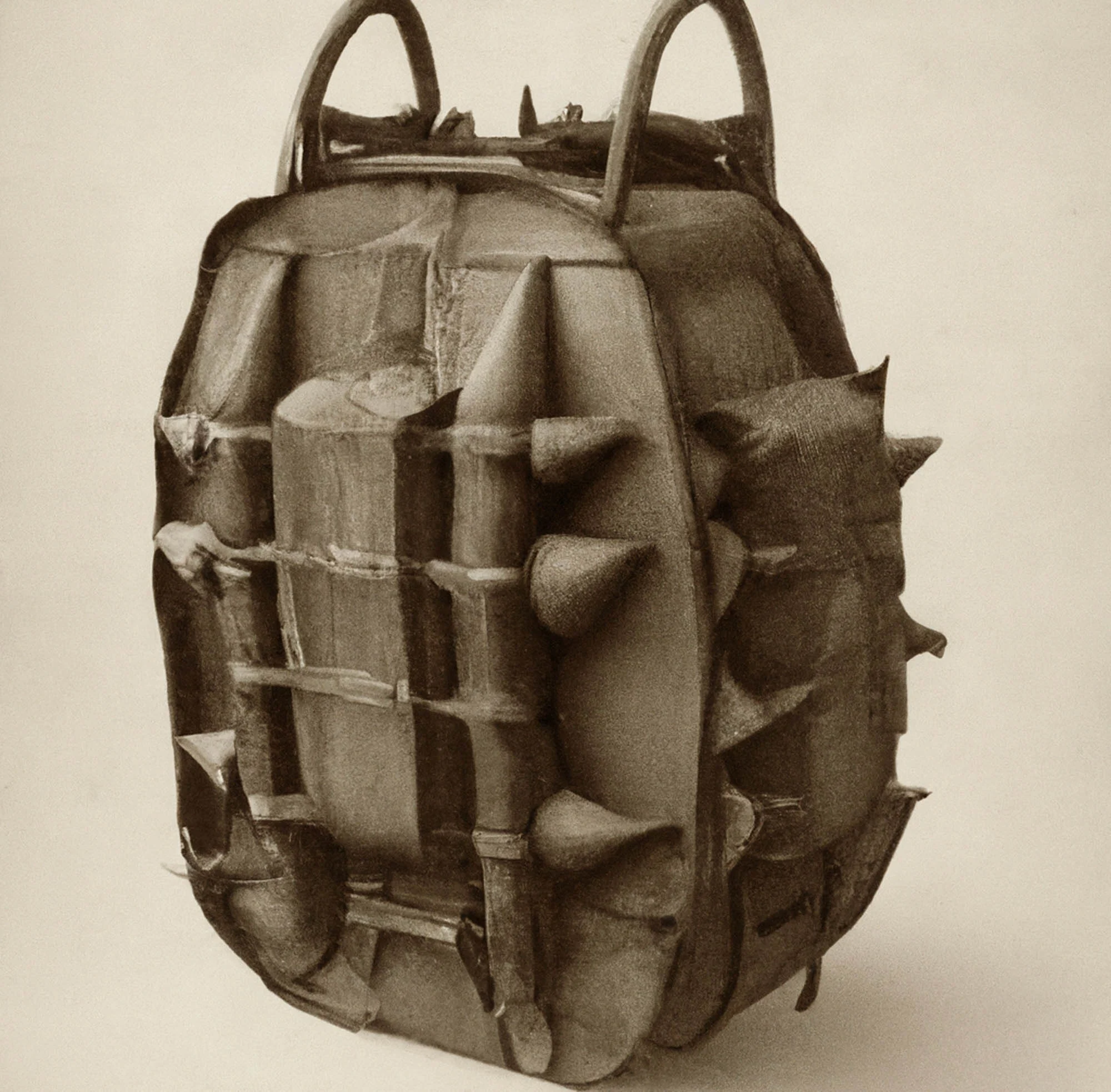

South African artists Francois Knoetze, Amy Louise Wilson (Lo-Def Film Factory) and Russel Hlongwane (Substance Point) present “DZATA: The Institute of Technological Consciousness,” a film that reimagines Africa’s technological history. Made up of intricate costumes, stunning landscapes, and AI imagery, the film (which is funded by the Mozilla Foundation) is inspired by the age-old African transcendentalists who would roam the lands amassing knowledge and materials. Here, Wilson, Knoetze, and Hlongwane, speak to Katie de Klee about some of the key aspects of the film, and outline why it’s so important to them to reframe the continent’s place in history—not as a mere recipient of technological innovation, but as a fertile ground of pioneering invention.
In a world where modern technology often dominates discourse, “DZATA: The Institute of Technological Consciousness,” a visually provoking and immersive video work, encourages a journey back in time. The brainchild of artists Amy Louise Wilson and Francois Knoetze, co-founders of Lo-Def Studio, together with cultural producer Russel Hlongwane, this unique project offers an alternative perspective on African history, technology, and knowledge, bridging the past and the future.
“DZATA” presents a fictional universe that's firmly grounded in a detailed exploration of Africa's historical and contemporary technopolitical landscapes. It carefully sketches out the multifaceted duties of the scientists within the fictional “DZATA” institute; supposedly founded in 1553, its roaming scientists are the focus of the film, as they traverse the continent with their mobile laboratories looking to develop indigenous technologies.
The project, Wilson explains, is inspired by Clapperton Chakanetsa Mavhunga’s idea of a mobile laboratory, embodying the age-old tradition of African transcendentalists (isanusi in isiZulu) who roamed from kingdom to kingdom, amassing different methods and knowledge.

“We took inspiration from this tradition of nomadic practitioners who move with their labs,” explains Hlongwane. Wilson continues: “We wanted to expand this idea to create a fictional institute of African scientists and technologists that has moved across the continent for hundreds of years, working with the technologies, materials and practices of each locale, becoming a kind of growing, mutating, migrating archive which incorporates socio-technical assemblages from different parts of the continent,” adds Wilson.
By highlighting these narratives and bringing them into the collective consciousness, “DZATA” aims to shift perceptions and foster a more nuanced understanding of Africa's role in the global technological landscape. The project endeavors to position Africa not as a mere recipient of technological innovation but as a fertile ground of scientific exploration, creative problem-solving, and pioneering invention.

The project deploys OpenAI’s DALL-E, an AI programme that generates images from text descriptions, which filled the gaps when the team were lacking visual references. “It was fascinating to see how machines [AI] could meet us with images for the stories we wanted to tell,” adds Hlongwane. “This is one small way that we’re putting technology to work, for the circulation of ancient African narratives of technology.”
The name “DZATA” is taken from the mysterious ruins of an ancient Venda kingdom, located in the north of South Africa. These ruins, renowned for their unusual dark-blue stone construction that echoes the architectural brilliance of the Great Zimbabwe ruins, are a testament to indigenous innovation. The artists see this complex stone construction as an early form of technology, a visual language of resilience and persistence that reverberates through the ages.
In the world of “DZATA”, ancient stone ruins collide with futuristic cyborgs, traditional practices intertwine with modern techniques, and the rhythm of Africa pulses beneath the hum of digital innovation.
The Costumes
In “DZATA”, innovation isn't characterized by “the new,” but by the transformative power of the overlooked and the discarded. Old tape cassettes, perlemoen shells, rags, CDs—materials that might otherwise be relegated to oblivion—are revived and refashioned into the scientists’ intricate costumes. This use of discarded materials disrupts conventional understandings of innovation, championing the concept that creativity and progress are not only about invention and novelty, but the imaginative reinterpretation of the existing.
These discarded objects, each carrying their own histories and narratives, are granted new life in the “DZATA” universe. Tape cassettes, once repositories of sound and memory, are now woven into the fabric of the project's archival costume, echoing with the resonance of past sounds. Perlemoen shells, artifacts of the natural world, become fragments of the characters' attire, grounding the digital universe in the tactile realities of the physical world.

The scientists are envisioned as ‘wearing’ their archive of knowledge, inspired by the true African transcendentalists whose “bodies were also labs as they adorned themselves with different metal objects that either strengthened their spiritual resonance or displaced negative energy they might encounter on their path,” explains Hlongwane.
“We were thinking about how little writing and research there is on examples of African technological innovation, apart from in the field of archaeology, and how this archive of knowledge has been passed down orally between generations,” says Wilson. “In oral societies [societies that have not yet developed literacy] one wears the collective knowledge.”
Another representation of the “wearing” of collective knowledge is the backpacks worn by the film’s roaming scientists. Each backpack, meticulously constructed by Knoetze from found materials and archival fragments, is more than a functional object. It signifies the collective repository of accumulated knowledge, the tangible representation of the “wearing” of that collective knowledge. Each component, each woven thread, is a symbolic representation of the lessons learned, the stories gathered, and the wisdom amassed in the institute's journey.

The Laboratories
The tent—containing the laboratory the scientists carry with them, intricately fashioned from discarded, overlooked, and reclaimed materials—signifies a transient home and a mobile operational base. They use their mobile laboratory to comprehend the world, documenting the institute's journey across the African continent over hundreds of years. It speaks to the adaptability inherent in the institute's philosophy, a testament to the idea that knowledge and innovation are not confined to specific spaces or structures. This tent represents a space of learning and creation that is as fluid and mobile as the knowledge it houses, reinforcing the project's emphasis on the interconnected flow of knowledge.
“The tent in ‘DZATA’ resonates deeply with my own artistic process, reflecting the themes of mobility, storytelling, adaptability, and resourcefulness that I explored in Cape Mongo and my travels across the African continent,” explains Knoetze. “It becomes a vessel for collecting fragments of cultural and social narratives, as well as a reminder of the privileges and challenges associated with mobility.”
The Great Drum
The Great Drum in DZATA is deeply embedded in both historical and symbolic significance. “It refers to the Ngomalungundu drum, which was carried by the Venda people on their migration south and finally set down at DZATA, the location of the current institute,” says Wilson. “According to the story, they were not allowed to set it down on the ground throughout their journey.” The drum was believed to possess magical powers that could incapacitate enemies during wars and induce a transcendental state in dancers during ceremonies.
More than an artifact, the drum signifies indigenous innovation, highlighting how ancestral technology paved the way for modern inventions. Regarded as the original telegraph, the drum predates both radio and cell phones. Zulumathabo Zulu's paper, “African Drum Telegraphy and Indigenous Innovation,” recounts an 1885 event when African revolutionaries announced their victory over the English army in Sudan through relay drumming, a remarkable achievement predating Morse code.

“We wanted to show examples of different kinds of ‘technologies.’ For example, material technologies (things we can feel and touch and know their use - e.g tools); or social technologies (songs, jokes, ideas); or communication technologies (drumming, smoke signals, language),” explains Knoetze.
Within the DZATA Institute, the drum assumes a futuristic role. The scientists study the drum as a tool of ‘Distributed Sonic Frequencies/Distributed Intelligence.’ Using Dall-E, Wilson, Knoetze and Hlongwane reimagined their drum-like machine as a futuristic symbol of indigenous knowledge.
The Inventions
The DZATA creators painstakingly designed and constructed a range of unique equipment and instruments, each brimming with conceptual depth and historical resonance. The equipment in DZATA serves to underline the narrative's themes of indigenous knowledge and Afrofuturism while showcasing the scientists' innate inventiveness.
Rags, typically symbols of neglect and decay, are transformed into emblems of resilience and renewal, while old CDs now glimmer with the reflective sheen of reclaimed memories. “Francois made a series of ‘impractical instruments,’” explains Wilson. “None of them function as machines—they are sculptural prototypes, and they offer an alternative to computational thinking or techno-utopianism.”

The filmmakers are also drawing attention to the environmental devastation caused by tech over-consumption. Knoetze highlights that while much of global connectivity relies on African raw materials, Africa often becomes the dumping site for e-waste from Europe and the U.S. This observation underscores the film's critical exploration of the societal and ecological consequences of technological practices.
“If we view science and technological innovation not as a ‘Houdini act of white people’ (from Clapperton Chakanetsa Mavhunga’s writing) but as a long chain of accumulated knowledge, then this film tries to zoom in on the makeup of that chain,” explains Wilson. “It’s about re-centring African modes of thought.”


